This post may contain affiliate links, please see the privacy policy for details.
Argentina is a vast country with many different places to visit and something for every taste. With its location in the southern part of South America, Argentina offers everything from bustling city life to rainforests and waterfalls, deserts and unique wildlife, mountains and endless roads. With so many options and beautiful places to visit in Argentina, it can be hard to decide where to visit first.

In the Subtropical North of Argentina bordering Brazil, you will find the dense and humid Misiones rainforest. As you travel towards the Northwest regions of Salta and Jujuy and the Andes region, the landscape changes. Here you will find impressive mountains, dusty towns, and long stretches of desert-like landscapes.

In Central Argentina, you find the country’s second-largest city, Córdoba, with its surrounding lusty green fields and mountains. Traveling south towards the Patagonia region, the landscape turns into fascinating raw nature with towering mountains and crystal-clear mountain lakes nested in endless national parks.
The capital city of Buenos Aires offers a cosmopolitan and lively city life. While the city still has a good portion of Latin America in it, you do see the strong European influence in its beautiful architecture. To the south of Buenos Aires, the beautiful beaches of coastal towns around Mar del Plata are a popular destination for the locals to escape the heat during the summer months (December to February).
The Best Places to Visit in Argentina
Buenos Aires
Buenos Aires is a place you can’t miss when you visit Argentina! The vibrant Argentine capital invites you to explore the cityscape and immerse yourself in the local specialties of big steaks and world-class wine.

This beautiful city is also the perfect spot to experience the mystery of the world-famous Argentine tango. Whether you prefer to seek out a street performance in San Telmo or go for a professional tango show in Puerto Madero, Buenos Aires is the best place to experience tango!
Buenos Aires is also the perfect safe place to start exploring the rest of Argentina. The capital city is well-connected to the rest of the country with two main airports, the International Airport Ezeiza and Aeroparque Jorge Newbery.
Top Places to Visit in Buenos Aires
The Pink House
Argentina’s presidential palace, also known as Casa Rosada in Spanish, is located in downtown Buenos Aires. The Pink House is a must-see place in Buenos Aires. The palace is located at the historic square Plaza de Mayo, or the May Square in English. From here you can also visit the city’s old town hall, El Cabildo, and Buenos Aires Cathedral.

San Telmo
San Telmo is the oldest neighborhood in the city and features beautiful old colonial houses, cobble-stoned streets, and unique small art galleries. On Sundays, you can experience the popular San Telmo Sunday Market. The Sunday Market is a perfect spot for shopping souvenirs.

San Telmo is also the perfect spot for experiencing locals dancing tango. On weekends, at Dorrego Square, you will find couples swinging their legs in a tango. You can also opt for a more professional tango show at Almacen Viejo in San Telmo.
Avenue 9th of July
Avenue 9th of July, or Avenida 9 de Julio in Spanish, is the widest avenue in the world. The avenue runs all through downtown Buenos Aires. It connects the northern neighborhoods of the city with the southern neighborhoods.
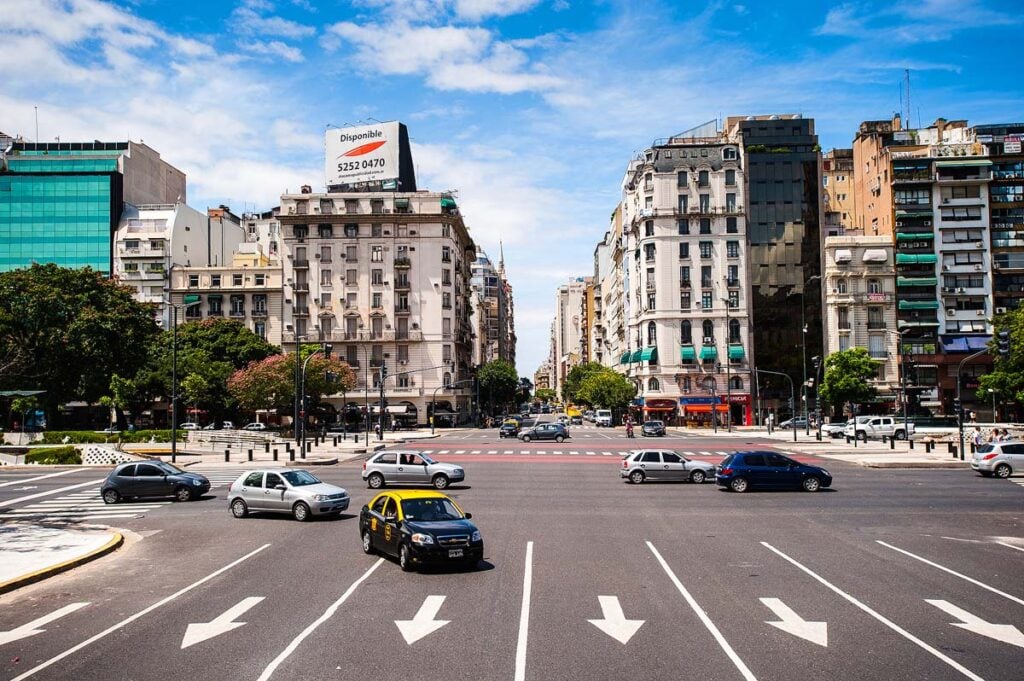
If you walk down the historical avenue of Avenida de Mayo from the May Square, you will come to the Avenue 9th of July. On the Avenue 9th of July, you can also visit the famous Colon Theatre, known to be the best theatre and opera house in South America.
Recoleta
If you have ever heard Buenos Aires referred to as the Paris of South America, then a visit to the Recoleta neighborhood will make you understand why.

In Recoleta, gorgeous old mansions lay side by side with Parisian-style palaces on board tree-covered avenues. Don’t miss out on a visit to the Recoleta Cemetery! The cemetery is one of the most popular Argentina tourist attractions and a truly spectacular place to visit!
La Boca
La Boca is a popular tourist attraction in Buenos Aires. You have most likely already seen pictures of La Boca’s cute colorful houses.

La Boca tells an interesting story of the city’s immigration past. During the 1880s and early 1900s, Argentina experienced huge flows of European immigration. Many of these immigrants settled in the port area of La Boca and used the leftover paint from the ships to paint their houses.
Today, La Boca has become more like an open-air museum with souvenir shops and restaurants. It remains one of the most popular tourist attractions in the city but is not a place where locals normally hang out.
Read more about how to spend three days in Buenos Aires.
Iguazu National Park
The Iguazu Falls is one of the absolute must-visit places in Argentina! If you don’t have it on your bucket list for Argentina, add it now!
The Iguazu Falls are located on the border between Argentina and Brazil in the Northern province of Missions in Argentina. The Iguazu National Park is declared a UNESCO World Heritage Site and is one of the most visited places in Argentina.
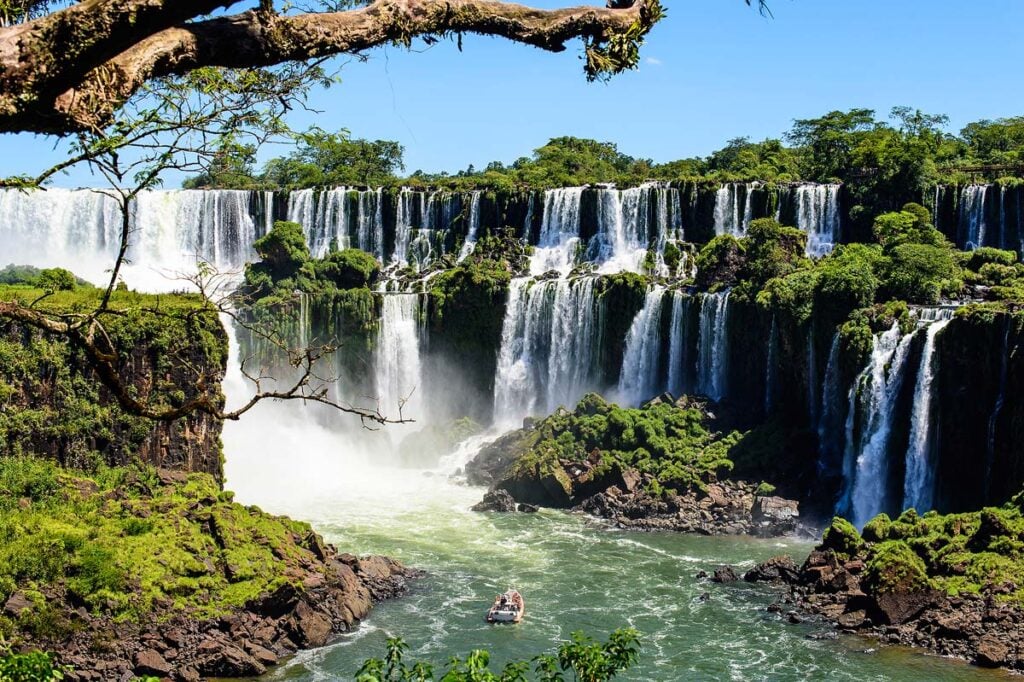
After many years of living in Argentina, the visit to the falls still stands as one of the absolute highlights. There is definitely a reason why the Iguazu Falls are one of the world’s natural wonders!
The Iguazu Falls is the largest water system in the world. The falls are made up of over 270 individual falls and springs. The most popular and fascinating part of the Iguazu Falls is the Devil’s Throat or La Garganta del Diablo in Spanish. The Devil’s Throat is the largest part of the falls with an observation deck overlooking the massive amount of water.
Throughout the national park, there are hiking trails that guide you around the area and offer you some unique up-close experiences with the waterfalls.
You can access the Iguazu Falls from either side of the Argentine-Brazilian border through the Iguazu National Park.
How to Get to the Iguazu Falls
To get to the Iguazu Falls from Buenos Aires, it is around a 2-hour flight or a 20-hour drive with a long-distance bus to Puerto Iguazu.
From Puerto Iguazu, you can take a local bus to the entrance of the natural park or hire a taxi. The ride takes around 30 minutes.
Valdés Peninsula
The Valdes Peninsula is one of the best places to visit in Argentina for nature lovers! On the Valdes Peninsula, you can experience penguins, sea lions, seals, and killer whales in their natural habitat. However, the Valdes Peninsula is most famous for being one of the best places in Argentina for whale watching.

The Valdes Peninsula is located on the Atlantic Coast in the northern part of Argentina’s Patagonia region. The incredible wildlife and its importance for the local ecosystem in Patagonia has granted the Valdes Peninsula the title of UNESCO World Heritage Site.
During the spring and early summer months (June to mid-December), the Southern Right Whales come to the calm waters surrounding the peninsula to mate and give birth to the pups.
Other amazing wildlife experiences you can have on the Valdes Peninsula include getting close to Magellanic Penguins in the penguin colonies of Caleta Valdés and watching sea lions and Elephant Seals sunbathing on the beaches around the peninsula. If you are lucky you might also spot a killer whale in trying to steal a baby seal.

The wildlife does not stay at the Valdes Peninsula all year round. So, before you plan to visit and book your flight tickets to Argentina, remember to check the Peninsula Valdes wildlife calendar.
On the Valdes Peninsula, there is only one small town called Puerto Piramides. Here you can find a couple of hotels and restaurants. During the whale season, whale-watching boat tours leave from Puerto Piramides. The closest bigger city to the Valdes Peninsula is Puerto Madryn, around an hour’s drive from Puerto Piramides.
How to Get to Valdes Peninsula
To get to the Valdes Peninsula from Buenos Aires, you can take a 2-hour flight to Puerto Madryn or Trelew.
You can also take a long-distance bus to either Puerto Madryn or Trelew. The bus ride takes 20 hours and 21 hours, respectively.
From Puerto Madryn or Trelew, you need to take a local bus or rent a car and drive to Puerto Piramides on the Valdes Peninsula. From Puerto Madryn, the drive is about 1.5 hours, and from Trelew around 3 hours.
Mendoza
Mendoza is a must-visit place in Argentina for wine lovers! The Mendoza province is located in Argentina’s wine region surrounded by the Andes Mountains.
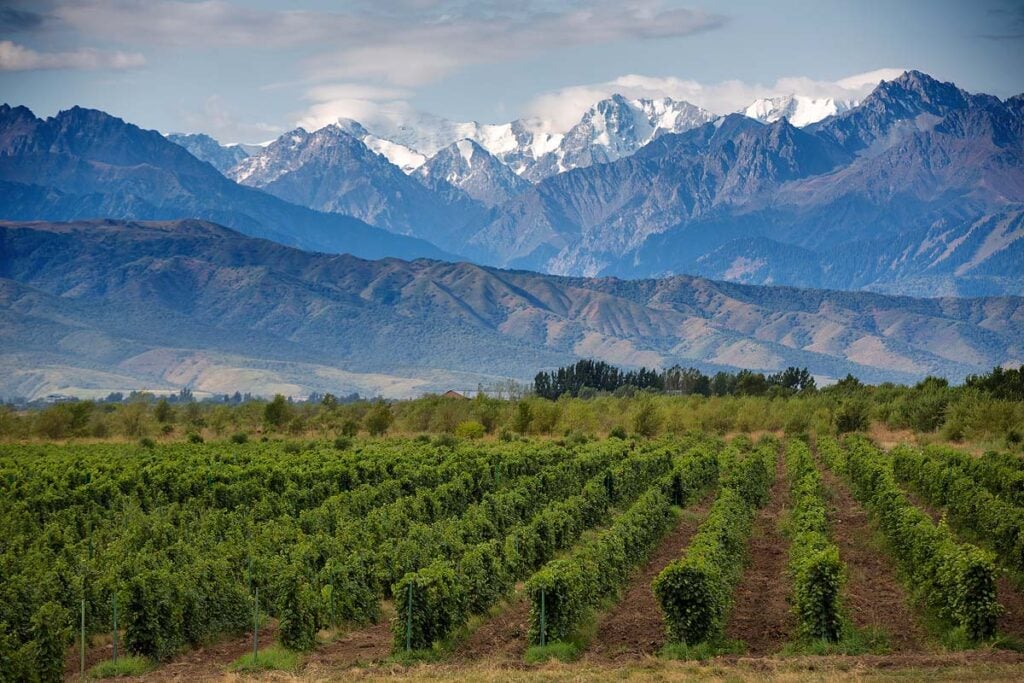
A visit to Mendoza’s wineries is the main tourist attraction. The wineries open their doors to visitors during the day, and some places might require reservation beforehand. On the winery tours, you come on a guided tour of the winery’s facilities, learn about their production, and lastly get to taste some of their wine. Most of the wineries in Mendoza are located outside the city, so it is recommended to sign up for a tour or rent a car to get around.
The most popular areas in Mendoza are Maipu, Luján de Cuyo, and Valle de Uco. Maipu is the area with the most wineries closest to Mendoza. It is easy to get to with public transportation from the city center. Luján de Cuyo is located a bit further away and is especially famous for its world-class Malbec wine. Valle de Uco is located an hour’s drive south of the city of Mendoza. The area is considered one of the best wine regions in Argentina.
While the wineries are the main attraction in Mendoza, it is also worth spending a day or two exploring the city center of Mendoza. Here you can visit the Independence Square in the city center, the Spanish Square, and the Hill of Glory; a viewpoint located just outside the city center. Mendoza is considered one of the safest cities in South America.
The Andes Mountains are another popular place to visit in Mendoza. It is a perfect spot for outdoor adventures such as trekking, horse riding, and rafting.
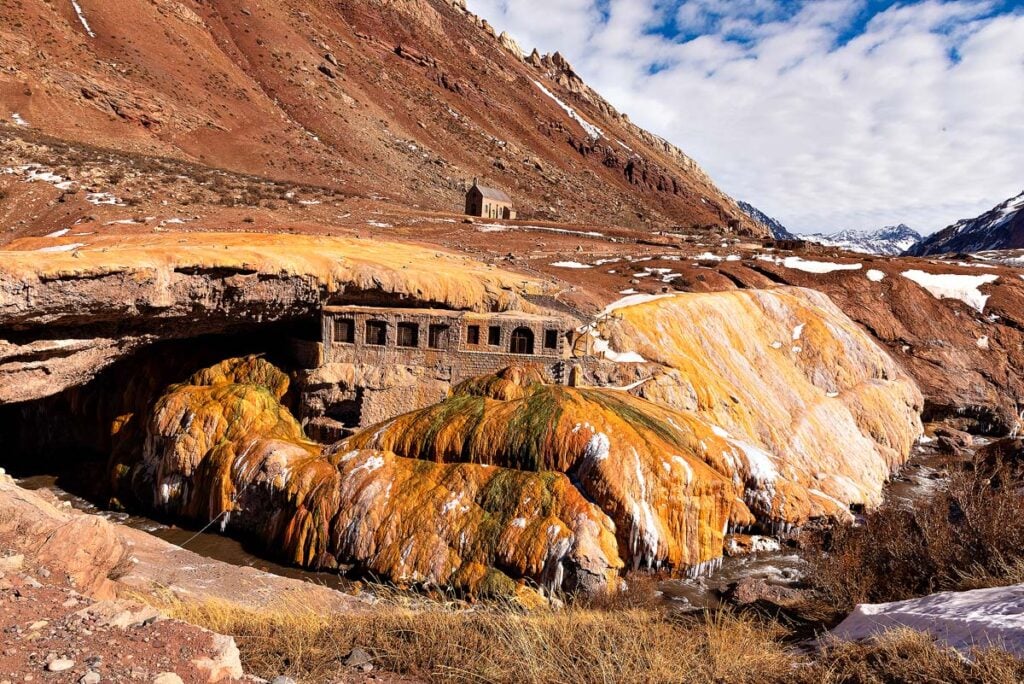
The Aconcagua Mountain is the highest mountain peak in the Americas (one of the many interesting facts about Argentina) and can be found in the Andes Mountains near Mendoza. Other popular activities include visiting the unique rock formations called the Inca’s Bridge (Puente del Inca) and the natural pools and thermal baths of Cacheuta.
How to Get to Mendoza
To get to Mendoza from Buenos Aires, there are several outbound flights a day. The flight takes around 2 hours. You can also take the around 17-hour drive with a long-distance bus.
Bariloche
San Carlos de Bariloche is one of the best places to visit in Argentina for mountain climbing, hiking, and skiing.
San Carlos de Bariloche is most commonly referred to as just Bariloche. Bariloche is part of Patagonia’s Lake District in the Argentine province of Rio Negro, and is located on the shore of the Nahuel Huapi Lake with the Nahuel Huapi National Park surrounding it.

A popular activity in Bariloche is to drive the Circuito Chico, translated as “the Small Circuit.” It is a circle-shaped road around 60 kilometers outside of Bariloche. By following the road around, you come by some of the most picturesque views in the area.
Other popular tourist attractions in Bariloche include tasting local chocolate, visiting the Swiss Colony, and exploring the city center’s German heritage. For the best views in Bariloche, take the cable cars up to the top of Cerro Otto mountain or a chairlift to the top of Cerro Campanario.
From Bariloche, you can also embark on the adventure of the Road of Seven Lakes. The Seven Lakes’ Road is the popular nickname of a part of Argentine Route 40. The road runs from the small town of Villa La Angostura, around an hour’s drive to Bariloche, to the town of San Martin de los Andes. On your way, you can visit some of the most scenic Patagonian landscapes.
How to Get to Bariloche
To get to Bariloche from Buenos Aires, you can take a 2.5-hour domestic flight. Another option is to take a long-distance bus from Buenos Aires to Bariloche. The bus ride takes between 22 hours and 24 hours, depending on the bus company.
Perito Moreno Glacier & Los Glaciares National Park
Perito Moreno Glacier is one of the most popular places to visit in Argentina. The gigantic glacier is located inside Los Glaciares National Park in the province of Santa Cruz in Argentina’s Patagonia region.
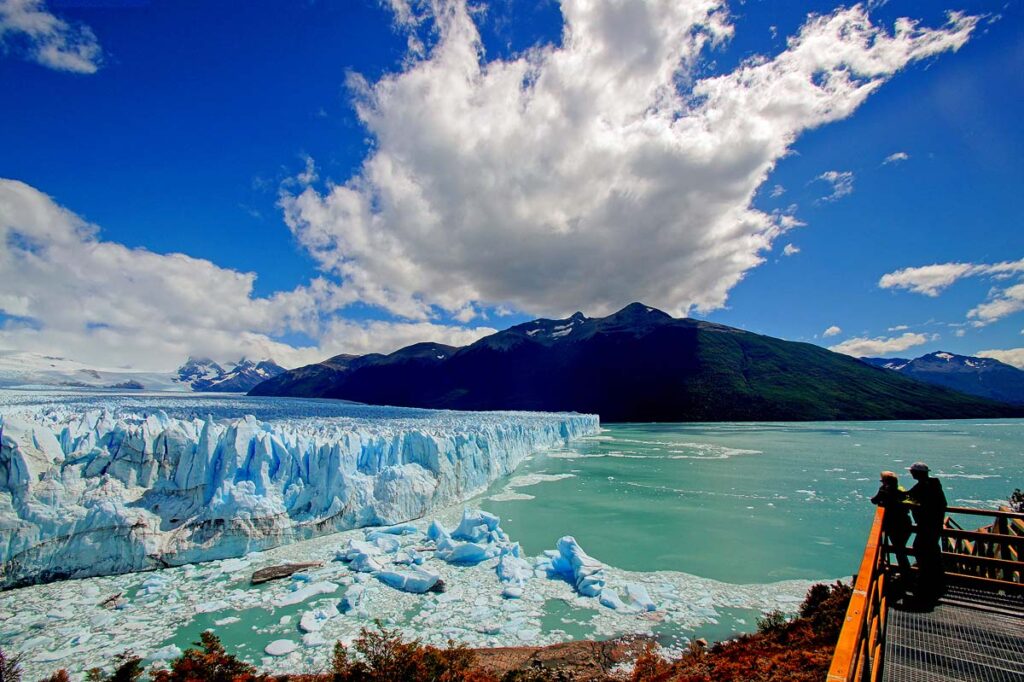
The natural park consists of several glaciers whereas the Perito Moreno Glacier is the biggest and most impressive. Together with the Iguazu Falls, Perito Moreno is one of the most popular places to visit in Argentina and one of Argentina’s seven natural wonders.
The closest town to the Perito Moreno is El Calafate. From here, you can either sign up for a tour of the Perito Moreno Glacier or rent a car and drive to the entrance of the national park.

The drive to the entrance of the natural park takes around one hour. On top of that, you should calculate at least 30 minutes of walking inside the park to get to the observation deck of the glacier.
Winters in Patagonia can be harsh and cold, so the best time to visit Argentina to see Perito Moreno is during the warmer summer months in Argentina (December to February).
How to Get to El Calafate
To get to the Perito Moreno Glacier, you can take a direct flight from Buenos Aires to El Calafate. The flight takes around 3 hours.
There are no direct long-distance buses between Buenos Aires and El Calafate. An option would be to take a long-distance bus from Bariloche to El Calafate. The bus ride takes around 27 hours.
El Chaltén & Fitz Roy Mountain
El Chaltén is one of the best places to visit in Argentina to explore the wilderness of Patagonia, and the perfect spot for adventure seekers and rock climbing.
El Chaltén is a charming small town in southern Argentina close to the border with Chile. The town is located inside the national park, Los Glaciares National Park, and is commonly referred to as Argentina’s National Capital of Hiking.

Many of the different hiking trips to experience Patagonia and its beautiful scenery start from El Chaltén. You can choose from 1-day hiking trips to several-day trips. There are so many pretty places in Argentina!
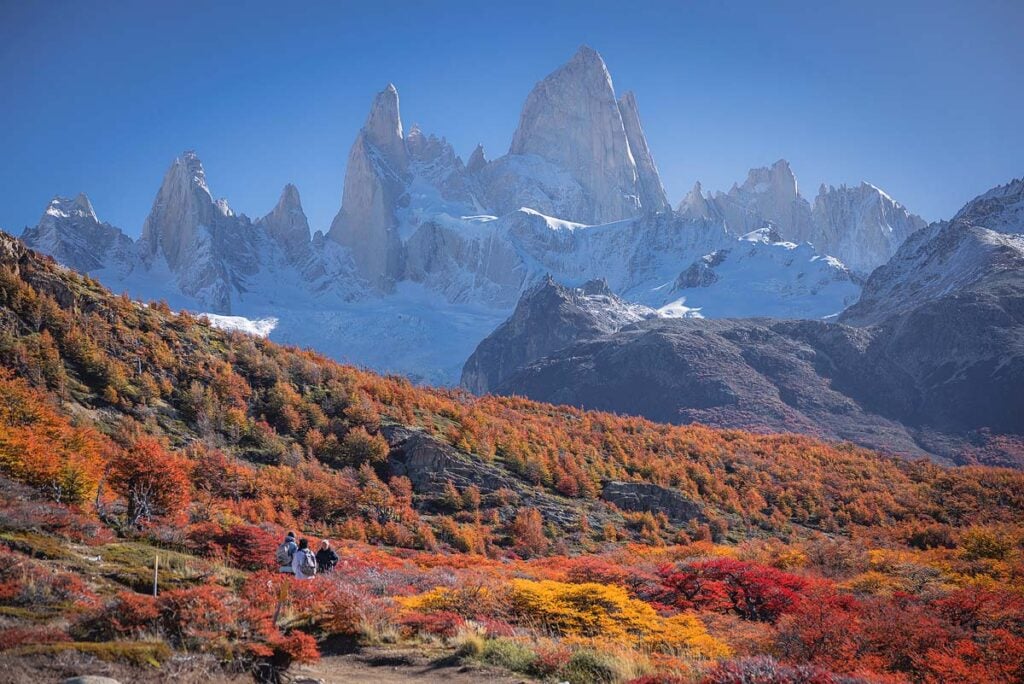
The most popular hiking trip is the Mount Fitz Roy Trek and the Cerro Torre Trek. You can do a combined hike for two days to experience the towering peaks of Cerro Torre and Mount Fitz Roy. Or you can opt for a 1-day hike of about 21 km to visit only the Fitz Roy Mountain and Laguna de los Tres, a crystal clear lagoon in between the mountains.
El Chaltén is definitely one of the best places to visit in Argentina if you love an adventurous outdoor experience on your travels.
How to Get to El Chaltén
To get to El Chaltén from Buenos Aires, you need to take a 3-hour flight to El Calafate and then a 2.5-hour bus from El Calafate to El Chaltén.
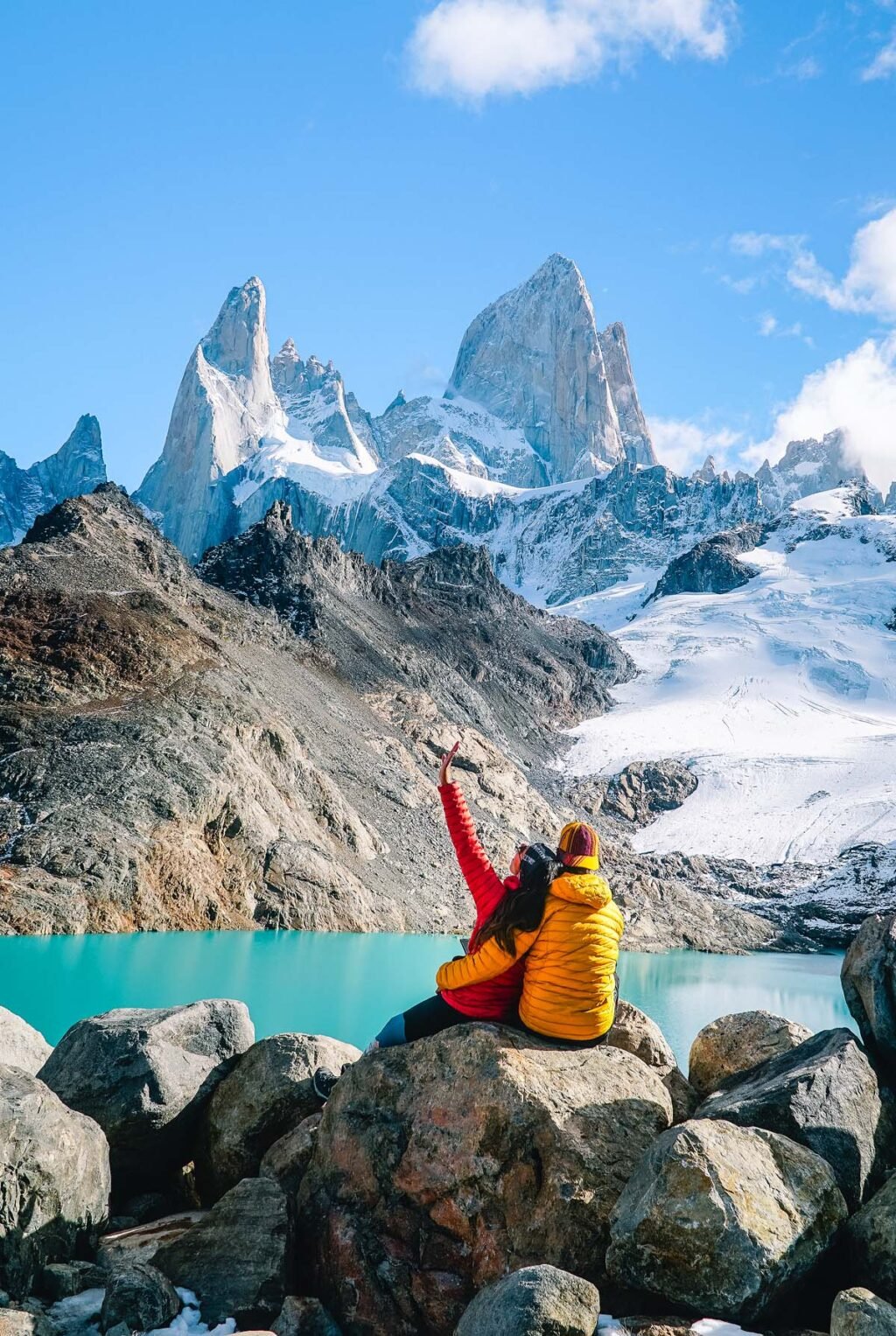
To get to El Chaltén by long-distance bus, you can take the bus from Bariloche to El Chaltén. The bus drive takes around 24 hours.
Ushuaia: The End of the World
Ushuaia is the world’s southernmost city and a gateway to Antarctica. The city is located in the Patagonian province of Tierra del Fuego in the southernmost part of Argentina. So, it is for a good reason that Ushuaia is often referred to as “The End of the World”.

Ushuaia is a busy port town and the capital city of the province of Tierra del Fuego located by the Beagle Channel. The Beagle Channel is the strait that separates the Chilean and Argentine parts of Tierra del Fuego and is a popular place to do a boat tour to experience wild sea lions and penguins.
Popular places to visit in Ushuaia include the End of the World Lightlight, officially known as Faro de San Juan de Salvamento in Spanish, the End of the World Museum, Maritime Museum, and the End of the World Train. These places offer a great opportunity to learn about Ushuaia and the Patagonian flora and fauna.
If you want to explore more of Patagonia’s wilderness with glaciers, mountains, and unique wildlife, the Tierra del Fuego National Park located near Ushuaia is a perfect place to explore for a couple of days.

Tierra del Fuego is both the name of the Argentine province and the archipelago that stretches over the southernmost point of Argentina and Chile. Tierra del Fuego translates to the Land of Fire. The name comes from the discovery of the archipelago by European explorers, where they were said to see smoke coming from the area.
The best time to visit Ushuaia to experience penguins and wildlife is between November and February when the penguins come to Martillo Island to mate. Due to its proximity to Antarctica, the best time to visit Ushuaia is generally during the summer months in Argentina. However, don’t expect warm days in Ushuaia! Temperatures normally don’t rise above 50°F (10°C).
How to Get to Ushuaia
The quickest way to get to Ushuaia from Buenos Aires is to take a 3-hour flight to the airport in Ushuaia.
There are no direct long-distance buses from Buenos Aires to Ushuaia. You would need to take the bus to Puerto Madryn, and then to Río Gallegos in the southern part of Patagonia. From Rio Gallegos, it is still a 12-hour bus ride left until you reach Ushuaia.
Purmamarca & Seven Colors Hill
Northwest Argentina is one of the less-frequent places to visit in Argentina for international travelers, but not less impressive for that reason.
If you are looking to experience tiny villages with small houses dotted between impressive multi-hued rock formations, you should consider a road trip to Northwest Argentina. The province of Jujuy is a province covering the northwestern part of Argentina bordering Bolivia.
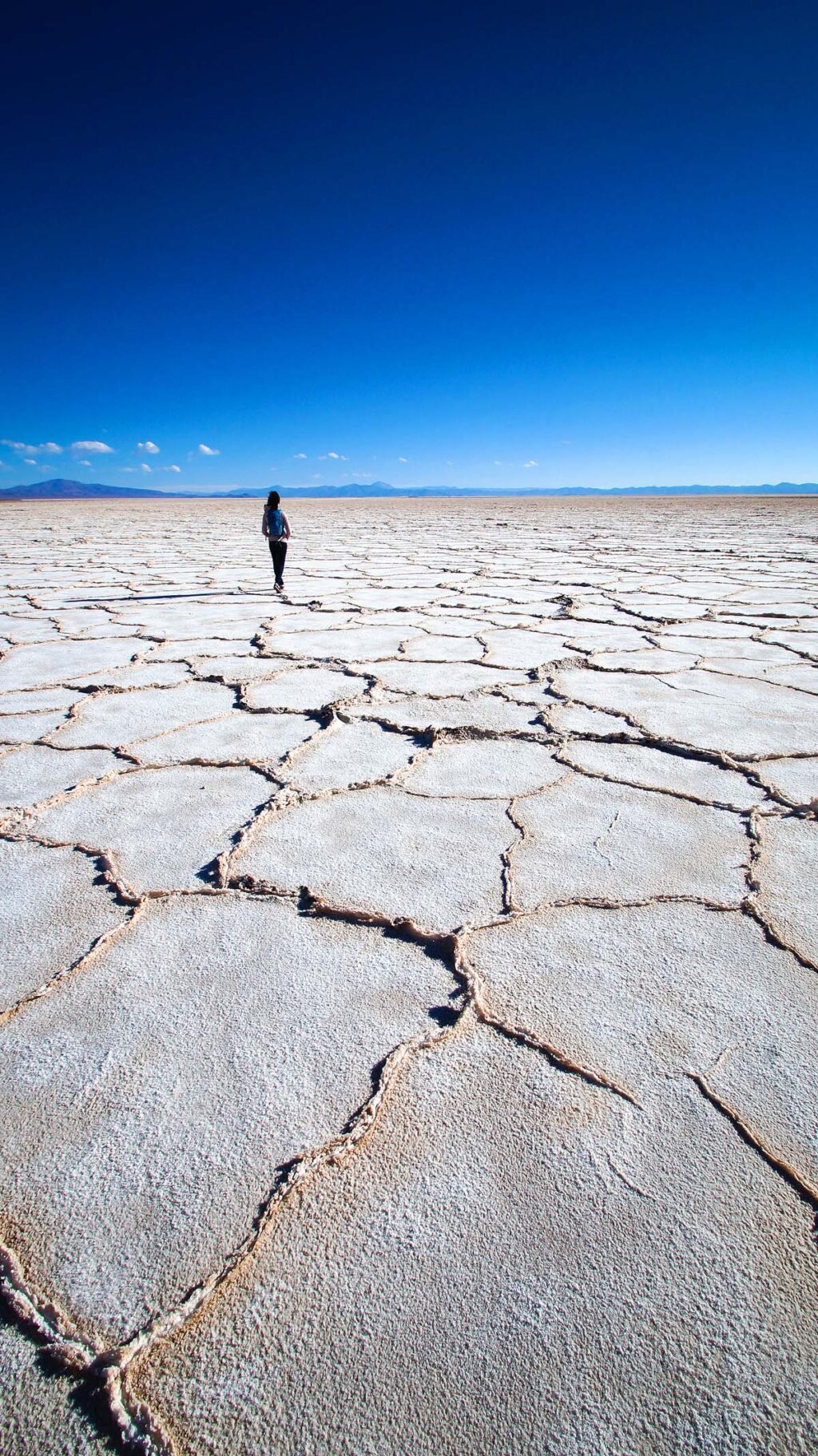
Purmamarca is one of the most visited villages in Northwest Argentina. In Purmarca, you can explore trekking trails between massive red and orange-colored mountains and admire the Seven Colors Hill.
The Seven Colors Hills – as the name indicates – is a rock formation that features seven different color tones. The mountain is located almost inside the village, and there is a small viewpoint from where you get great views and pictures over the mountain.
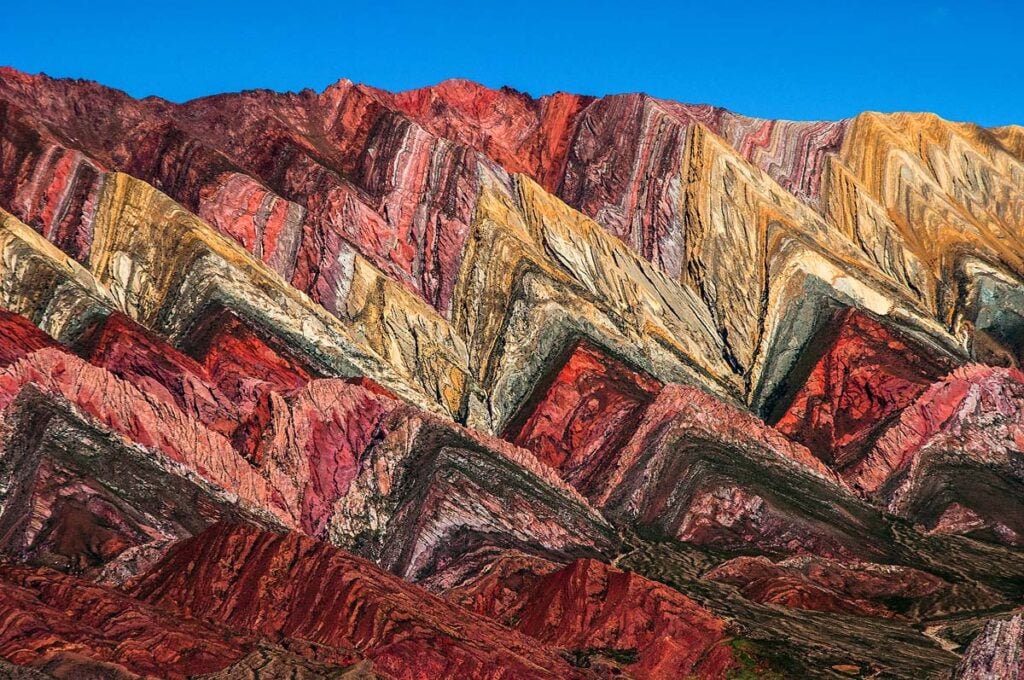
The Seven Colors Hills is the southern part of the mountain chain Quebrada de Humahuaca. The Quebrada de Humabuaca is another UNESCO World Heritage Site in Argentina, and it stretches all the way up through northwest Argentina.
The salt flats las Salinas Grandes is another popular attraction close to Purmamarca. Las Salinas Grandes are similar to the popular salt flats in Bolivia, Uyuni Salt Flat, just smaller. From the parking lot of Las Salinas Grandes, there are tours leaving to go out on the salt flakes or you can book your tour beforehand.
How to Get to Purmamarca
To get to Purmamarca from Buenos Aires, you can take a 2-hour flight from Buenos Aires to Salta. From Salta, you can take a local bus to Purmamarca. The bus drive is around 3.5 hours. You can also rent a car in Salta and drive up to Purmamarca.
Another option to get to Purmamarca from Buenos Aires is to take the long-distance bus from Buenos Aires to the nearby town of Tilcara. The bus drive to Tilcara takes around 23 hours. From Tilcara, you can either take a local bus, rent a car, or hire a taxi. The drive from Tilcara to Purmamarca is around 20 minutes.
Humahuaca & the Fourteen Colors Mountain
The Fourteen Colors Mountain is the most impressive part of the UNESCO-declared mountain chain the Quebrada de Humahuaca in Northwest Argentina, and a truly breathtaking experience!
While the Seven Colors Hill in Purmamarca is more well-known, the Fourteen Colors Mountain in Humahuaca is much more impressive! Both the location and the color variety of the mountains make the Fourteen Colors Mountains one of the most unique places to visit in Argentina.

The Fourteen Colors Mountains’ official name is Serranias del Hornocal but they are more commonly known in Spanish as Cerro de Catorce Colores (mountain of fourteen colors). The mountains are located at 4,300 meters above sea level in the middle of nowhere.
When standing at the viewpoint in front of the mountains, it’s a dramatic scenery with the clouds floating and the thunderstorms building up between the mountains. The viewpoint over the Fourteen Colors Mountains is located a good one-hour drive on bumpy mountain roads from the nearby village of Humahuaca.

The village of Humahuaca is also worth a visit. The village has the classic low houses and cobble-stoned streets of Northwest Argentina. You can visit the town hall, el Cabildo, and try the local specialties of Humita and Tamals. For a great view over Humahuaca, visit the Monument for Heroes of the Argentine Independence War.
Humahuaca is located around an hour’s drive from Purmamarca, so you can easily make a day trip out to visit Humahuaca and the Fourteen-Colors Mountain.
How to Get to Humahuaca
There are no direct flights from Buenos Aires to Humahuaca. To get to Humahuaca, you can take a 2-hour flight from Buenos Aires to Salta. From Salta, you can either rent a car or take a local bus. The bus takes around 4.5 hours.
You can also take a long-distance bus from Buenos Aires all the way to Humahuaca. The drive takes close to 24 hours.
How Long Do You Need in Argentina?
When planning a trip to Argentina, you should keep in mind that the distances in South America are huge. Argentina is, after all, the eighth-largest country in the world. There are so many places to go in Argentina, so plan time to see as much as you can.
Transportation and logistics in Argentina are not always great. In many cases, you will find that there are no direct flights between the major cities in Patagonia and the North of Argentina. You will need to return to Buenos Aires to fly out again from there.
The other alternative is to take long-distance buses between the places to visit in Argentina. However, a long-distance bus from one destination in Argentina to another can easily take up to 20 hours. You can check the time schedule for long-distance buses in Argentina at BusBud.
Add Argentina to Your Bucket List!
Argentina is a country that offers a diverse range of experiences for travelers. From the bustling streets of Buenos Aires to the natural wonders of Patagonia. The destinations we have explored here are just a small selection of the many incredible places to visit in Argentina. Whether you are seeking adventure, relaxation, culture, or the beauty of nature, Argentina has it all. So, pack your bags and get ready to explore this beautiful country and all that it has to offer.
You Might Also Like


Rebecca Hoffmann
Rebecca is a long-term Danish expat sharing her experiences and insights on life abroad on Becci Abroad. Having spent over a decade in diverse destinations, from Cuba and Spain to Sweden and Argentina, she offers her best tips on both travel and moving abroad. Her mission is to inspire and empower you to embark on your own global adventure, starting with Argentina and beyond!












